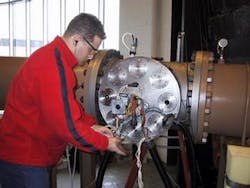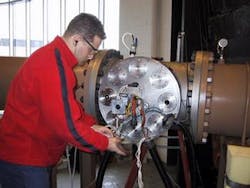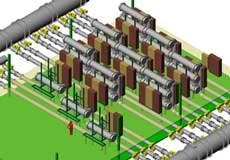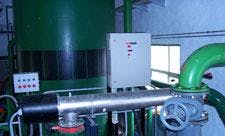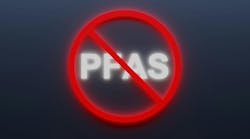By Bill Cairns
UV technologies have become increasingly the choice for not just disinfection of water and wastewater, but for remediation of various chemical contaminants using UV photolysis or UV plus oxidants in Advanced Oxidation applications. As part of a treatment process, UV technologies make significant contributions to multiple barrier strategies for protection of public health and can additionally bring cost and performance advantages over alternative options.
In a multiple disinfectant strategy, UV inactivates pathogens that are almost totally resistant or very resistant to chemical disinfectants (e.g., totally resistant Cryptosporidium, and very resistant Giardia, and Legionella in the case of chlorine disinfection). UV thereby allows reduction in the high dose of the chemical disinfectant that would otherwise be needed for control of the very chemically resistant pathogens. Low water temperatures dictate higher chemical disinfectant doses, which can be influenced by water pH.
The use of UV to avoid biology-dictated or water quality-dictated high chemical disinfectant doses results in fewer chemical disinfection by-products, and therefore an improvement in both the biological and chemical quality of the water produced using a multiple disinfectant strategy. Although many communities will use a dual disinfectant strategy of UV followed by a chemical residual, a relatively low UV design dose can provide broad pathogen protection in communities where a residual chemical disinfectant is not added because of high quality source water and/or an extensive treatment process and/or a well-maintained distribution system. Recently the most common design dose used successfully in Europe and North America is 40 mJ/cm2. The low UV design dose protects against UV-sensitive protozoan parasites and some similarly sensitive bacteria, the intermediate UV-sensitive bacteria and similarly sensitive viruses, and the more UV-resistant viruses of epidemiological significance such as rotavirus. Water quality also influences the appropriateness of using UV just as it influences the appropriateness of using other disinfectants.
In summary, the key criteria when considering whether to select UV technologies over alternative technologies are:
• Performance effectiveness (breadth and extent of target contaminant reduction);
• Variation in water pH and temperature that might add complications to a chemical treatment alternative solution but less likely to do so in an UV solution;
• Water quality parameters such as UV absorbing compounds within the water and/or the presence of suspended solids that can influence UV and non-UV technologies in similar or different ways;
• Reduction of by-product formation potential (by UV alone and by the whole process into which UV is integrated);
• Benefits of multiple barrier strategies for protecting public health by reducing dependence on a fewer number of barriers, any one of which may be compromised in operation and performance and therefore could benefit from an overlap in performance with another barrier, and none of which may provide the performance that can be realised with UV alone or in combination with the other unit operations and;
• Cost relative to non-UV technology options.
UV technologies are now available in a variety of configurations, including open channel gravity feed, closed pressurised feed, monochromatic lamp radiation, polychromatic lamp radiation, parallel-to-flow lamp orientation and cross-flow lamp orientation. They may include cleaning mechanisms, online control to modulate dose delivery to meet demand or come without dose delivery modulation. The variety of options in the marketplace has sometimes created confusion for end users and even regulators. The plethora of claims by manufacturers in support of their particular technology have sometimes hampered the end user from making the UV technology choice that is most suitable for the specific site being considered. A manufacturer of a full range of technology configurations is able to take a more holistic and less biased perspective when addressing the site specific needs of each end user. When manufacturers can draw both from their broad field experience and from their extensive knowledge base created by intensive research and development, several perspectives inevitably emerge, which serves the end user well.
First, when UV is a good solution for a particular generalised application (e.g., disinfection, specific chemical contaminant destruction), there is not necessarily one UV technology that is best for all sites engaged in the same application.
Second, different UV technologies have their strengths and weaknesses, and the optimised solution must be found for each client's particular application variation, water quality, economic environment and other factors.
Third, a site-specific UV solution is a function of the integrated package (lamp, reactor, cleaning mechanism, monitor technology, control technology, etc), and not simply related to the choice of the lamp used in the technology.
Fourth, working with the client to find the best technology to meet the client's needs is preferable to trying to convince the client that a particular technology meets the client's needs.
Finally, an end user who participates in the selection process and/or is aware of why a particular option is being recommended is more appreciative of the reasons why another end user may have selected a different technology for the same application. Most importantly, both end users are satisfied that they found an optimal solution for their own needs.
Selection of an UV technology that is optimised for the site specifics of a given application (e.g. disinfection, chemical contaminant destruction) would normally consider the following variables and their implications for the selection of the correct UV technology for that site:
• Available space for the treatment technology compared with the footprint required by various UV technology options at the peak design flow rate;
• Land, buildings and installation costs for the technology as well as the capital costs associated with the various UV technology options;
• Water quality parameters such as the absorption spectrum over the effective (e.g., germicidal, photolysis) UV wavelengths and impact on efficient use of the lamp emissions over this wavelength range and hence on the number of lamps required, replacement lamp costs and ultimately on net present value over the life of the technology;
• Electricity costs and impact on operating costs and net present value;
• Composition of the water matrix of organic and inorganic chemicals, and potential to exceed a regulatory limit on the production of by-products (e.g., nitrite from nitrate) when the combination of by-product precursor concentration, emitted wavelengths from the lamps, and UV dose are concurrently considered;
• Water quality parameters influencing fouling of UV-transmitting optics and implications for cleaning technology requirements and associated costs, and;
• Availability of bioassay or other empirical validation data for the UV technologies being considered to ensure that empirical rather than theoretical or calculated performance is the basis of technology comparison and design over the range of water qualities, flow rates and power levels being considered.
Users and potential users of UV technology must recognise the factors involved in making the decision to use UV technologies as opposed to alternatives, and in making the decision of which UV technology to use are numerous, but manageable with the appropriate knowledge base. The choice of an appropriate UV technology does not depend solely on the nature of the UV lamp used, but is a function of the entire UV technology, including lamp, reactor, cleaning mechanism, monitors, controllers, etc). The choice depends on the ways in which that entire technology interfaces with application variables, such as target contaminant and water quality, economic pressures (electricity costs, available budget, etc), and site limitations (e.g. footprint limitations).
Manufacturers with a long history of offering a broad range of UV technology configurations have of necessity had to assess variables and develop tools to provide their clients with the best solutions from amongst their numerous offerings. Such manufacturers provide good strategic partners for clients who seek the quality of service that springs from an intensive research and development program and from a knowledge-based approach to UV technology development, manufacturing and client servicing.
Author's note
Bill Cairns, the chief scientist for Trojan Technologies Inc, is based in London, Ontario, Canada. Trojan manufactures a full range of UV technology configurations. http://www.trojanuv.com
